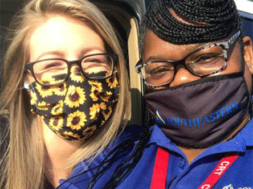
Strong Start – Orienting Students to Success
By Martha Lanaghen, Founder and CEO, The Sparrow Group
Students enter a university program unsure about a lot of things:
- Is this the right school for me?
- Can I succeed here?
- Are there any students here that are like me?
- Do teachers care about students? Do they want to hear from me?
- What if…
Particularly given the upheaval that has been 2020 to date, students will enter future programs more uncertain about the value of college and more fearful about their own future.
Long before Coronavirus was a thing, we worked with a multi-campus college system to evaluate orientation programs with the hopes of increasing start rates, and more importantly, increasing what we called, “First Term Continuation.” (The percent of students that were active on add/drop of their first term, that were still active on add/drop in their second term.)
The process
We started by doing quantitative and qualitative research (surveys, interviews and focus groups). We elected not to focus solely on those that dropped out, but cast our net wide enough to also include those that persisted so we could understand the key differences and develop actionable insights to improve our key outcomes.
We learned a lot. Some of which made us feel daft that we hadn’t realized it before.
For example, in one of our focus groups, when asked why she was able to persist to graduation, one of our subjects said, “When I was a freshman, one of my professors, Mr. Thomas (not his real name), told me he believed in me.
He said, “You can do this.” She went on to say that no one had ever believed in her like that, when she doubted herself, she thought of Mr. Thomas, and she pushed through.
The bottom-line from all the research was that most students stopped- or dropped-out because they were afraid of something. Those that succeeded were still afraid of the same things, they just had resources in themselves, or knew they had access to resources at their school that could help them persist no matter what.
We identified core fears shared by most students, then we changed orientation and early-tenure student services to ensure that students were ready to combat those fears. The result was a 200 basis point improvement in lead to start and nearly 80 basis point improvement in first-term continuation.
Combatting fears to increase persistence
What the student feared:
“I’m afraid I can’t pay for college.”
What we did:
Dramatically simplified financial aid packaging process to include a short video that broke down the kinds-of aid available (my money, grants, scholarships, loans, etc.), and a “Financial Aid Roadmap” that had checkboxes next to the steps and required materials to meet each step. We learned from the successes of systems like Singapore Math and included simple and approachable caricatures and illustrations that helped the checklist feel approachable and easy to navigate. Then, the student portal was updated to indicate exactly where the student was in the process, and what was left to do.
Finally, we completely re-wrote all of the Financial Aid Award Letters to ensure that they were plain and simple. Straight talk about every penny awarded, and the amount of money the student would owe out of their own pockets.
What the student feared:
“I’m not sure I can succeed in college.”
What we did:
We heard from our students that the first couple of terms/semesters were the hardest, in particular, their first mid-term period made them question their abilities academically. We saw many students drop out during this window, and we heard from successful students that they felt alone, and “like they’d been hit by a Mack Truck.”
So, we added the “Mack Truck” story to our orientation program. We told students, “you might struggle – most students do.”
And we told them they might get to mid-terms and feel like they’d been hit by a truck. “This,” we said, “Is normal. You are not alone. We can help you, and you can help yourself.”
We also learned that students come to college without self-advocacy skills in many instances. They are afraid to ask for help, even if they know where to go to get it. We created a system called “SOS” – which stood for “Sign of Strength” and then reminded students that asking for help is a Sign of Strength. We tried to normalize the need for help by telling students how many hundreds/thousands of SOS calls we get each year. The first term we implemented SOS, we saw an increase in student inquiries to tutoring and library services. It worked.
What the student feared:
“Teachers don’t care about students.”
What we did:
Many schools have implemented freshman seminars, or a school skills curriculum. We took it a step farther and created an entirely new faculty protocol for all typical freshman courses – the foundational Math, English, Business, etc. courses that are usually filled with first-year students. The key elements of this new faculty protocol included:
- Required eight-hour training focused on student feedback systems, course engagement, and student outreach (part of this training focused on tools for teachers to quickly learn student’s names, and greet students each day for class so that students felt seen and respected as individuals)
- Increased the stipend for all first-year instructors that completed the course
- Required additional office hours for those courses, as well as at least one personal outreach to every student in each of the courses
- Reduced the average class size for first-year courses
- Revised the grading rubrics for all courses to:
- Eliminate loss of points for formatting errors (APA, etc. – instructors could still critique formatting, but could not deduct points for formatting errors)
- Required that no single assignment was worth more than 30% of the course grade. If a major paper was a primary component, it was broken into milestones each of which was graded separately.
- Required instructors to return feedback to students within 48 hours of assignment submission, or before another assignment was due, whichever came first – so that students could incorporate feedback on early assignments into their later work.
What the student feared:
“Will I find other students here that are like me?”
What we did:
All orientation programs were either scheduled by program/school or, at some point, the attendees broke into program groups to discuss what it would be like to attend school. During these breakouts, every student was invited to meet several others, and they all exchanged cell phone numbers. We did “icebreakers” aimed at getting students to reveal their fears and concerns about college, and share what they feared as well as what they were looking forward to and why they chose this area of study.
These deep connections, and the shared cell phone numbers, helped students see two important things: 1) other people like them would be in their classes, and 2) everyone has fears about college.
When students started their first courses, if someone was absent, an instructor could ask the class to reach out to their friends and make sure they’re ok, and that they get the notes for the session they missed. Absenteeism dropped amongst those students that participated in this orientation program, and who received outreach from their peers when they were absent, rather than from the school or an instructor.
Creating experiences to help students feel the answer to their fear
It was our experience that modifying orientation to “talk” about things did not have the same impact as creating an experience that helped them feel the idea we were trying to convey. It wasn’t enough, for example, to just say, “Mack truck coming.” We walked them through a time management exercise so they could see how their time management needed to change, then we told them a true story about a freshman we had worked with (It’s not cheating to get your best storyteller to tell a moving story like this one so students really understand what’s coming!).
We closed all of our orientation programs with “Everyone Wins BINGO” – which is a blast (do an internet search for the name and you’ll find instructions and a video or two). It raised the energy and gave everyone a chance to succeed. Best case, you’ll have a prize for everyone that plays (t-shirt, bandana, hat, etc. – something with the school logo). They’ll leave your orientation saying things like, “I belong here,” and “I made the right choice.”
MARTHA LANAGHEN founded The Sparrow Group over a decade ago, to focus on improving student learning, retention and employment outcomes across higher education around the world.
Today, her clients span multiple continents and The Sparrow Group team has impacted hundreds of thousands of student lives through innovative programs that engage students. Her clients include UNCSA, Knowledge Universe, University of Texas, Monash University (Australia), and more.
Contact Information: Martha Lanaghen // CEO and Founder // The Sparrow Group // Martha@SparrowGroup.biz // www.LinkedIn.com/in/MarthaLanaghen







